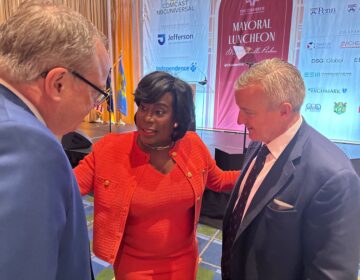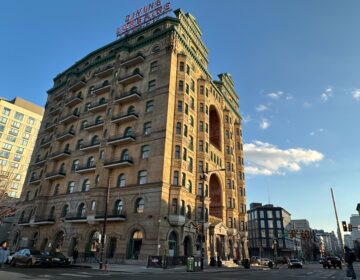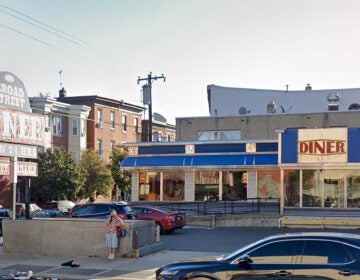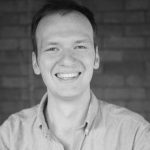Residents from across Northwest Philly come out to talk about the future of their neighborhoods
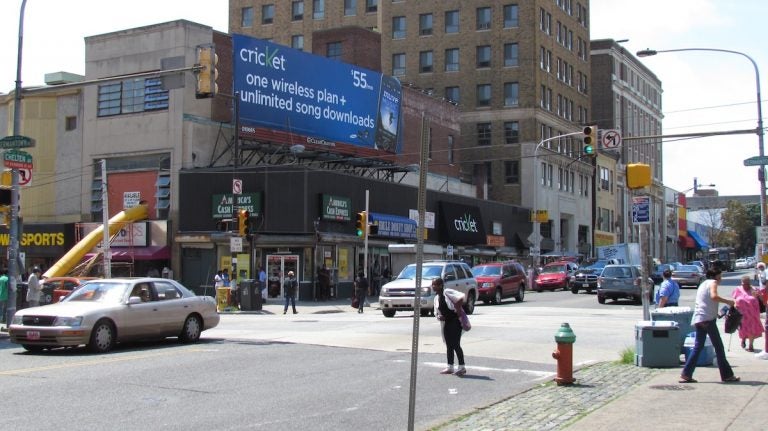
A long line snaked out from the Lutheran Theological Seminary’s Bembow Hall in Mount Airy on Monday evening. The occasion wasn’t spiritual though, at least not in a traditional sense.
More than 350 people had come out on a cold weeknight for the first public meeting of a long-awaited city planning process for one of the city’s most racially integrated and architecturally impressive areas — the Upper Northwest district that runs along the length of Germantown Avenue from Wayne Junction to the top of Chestnut Hill.
A map at the entrance asked attendees to place an orange sticker on the section of the district they call home. Entire neighborhoods vanished in a sea of stickers. As the map demonstrated, representatives from across the almost six-mile long district came out, with only portions of lower-income East Germantown and the mansion-heavy section of Chestnut Hill seen in small numbers.
“Only the very poor and the very rich didn’t come out,” said Philadelphia Magazine reporter Sandy Smith,, who attended the Philadelphia Planning Commission session as a resident of East Germantown.
The Upper Northwest is known for strong political and civic engagement. Stretching from Chestnut Hill, one of the wealthiest corners of the city through historically integrated Mt. Airy, and Germantown, which is home to more low-income, working-class, and African American residents, the district is grappling with an array of issues as its historic neighborhoods face development pressure in some quarters and continuing divestment in others.
The Upper Northwest is the last of the city’s 18 districts to go through the public process, aimed at bringing citizens into a planning project that launched in 2011 when the Commission adopted the Philadelphia 2035 Citywide Vision.
Relatively few politicians have attended previous district planning sessions, a symptom of the council’s tendency to ignore its recommendations. But this time Councilwoman Cindy Bass, who represents almost the entire area covered in the plan, gave a speech at the beginning of the event and fielded constituent questions until the seminary closed.
The area’s diverse population and racially integrated fabric came up several times throughout the spirited public meeting. While Germantown is majority black and Chestnut Hill predominantly white, these neighborhoods are not as hyper-segregated as many areas of the city. Most parts of East Germantown, for example, have a white minority. Mount Airy remains one of the city’s most integrated areas though Germantown Avenue is a dividing line between mostly black East Mount Airy and West Mount Airy, which is much whiter and more affluent.
“The district is racially mixed and very few census tracts have an overwhelming majority of one race or another,” City Planning Commission staffer Ian Hegarty told the crowd. But diversity isn’t the same as equity and some attendees raised concerns about racial dynamics in the room and the district more broadly. A resident of East Germantown, Daniel Harris, said that racial segregation is more profound in Philadelphia than in Atlanta (where he lived previously).
“Look who turned out,” said Harris, a graduate of the Citizens Planning Institute, gesturing towards several tables of majority white residents. (Harris is African-American.) But he nonetheless expressed enthusiasm about the process, saying that he appreciated the effort and that planners have a big role to play in creating “the beloved community.”
Harris and several other attendees recommended having future meetings further south on Germantown Avenue, closer to the more heavily African-American sections of the district.
Other recurrent themes included the need for economic development on Chelten Avenue and Germantown Avenue, especially south of the Mt. Airy business district. Residents also called for more protection of historic buildings in the district. Although Germantown has long been the second most prominent area of concern for the Preservation Alliance of Greater Philadelphia, the Upper Northwest district contains only 550 of the 23,000 properties in the city that are historically protected.
There will be two more public meetings in the Upper Northwest planning process late this year, in March and June.
WHYY is your source for fact-based, in-depth journalism and information. As a nonprofit organization, we rely on financial support from readers like you. Please give today.




